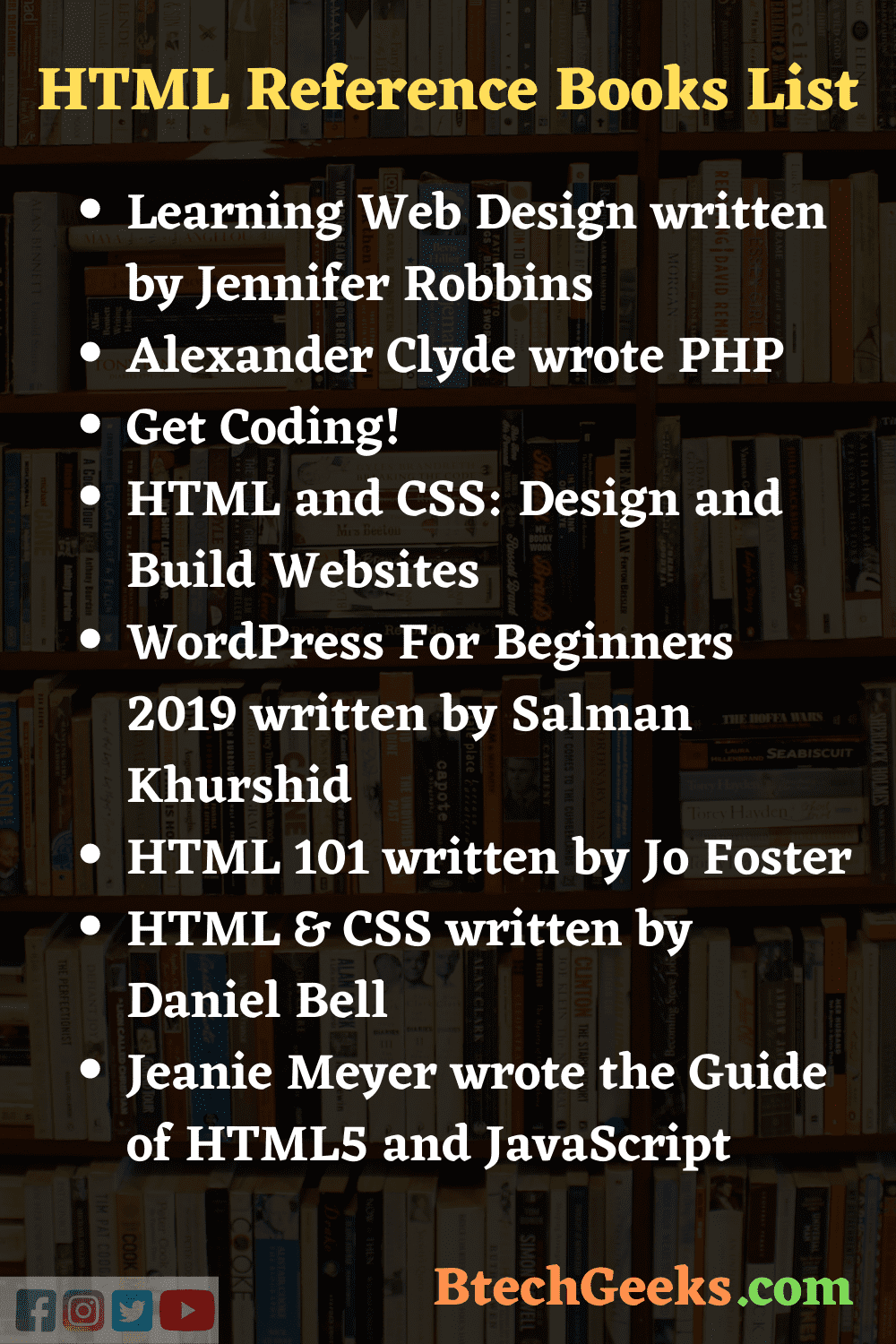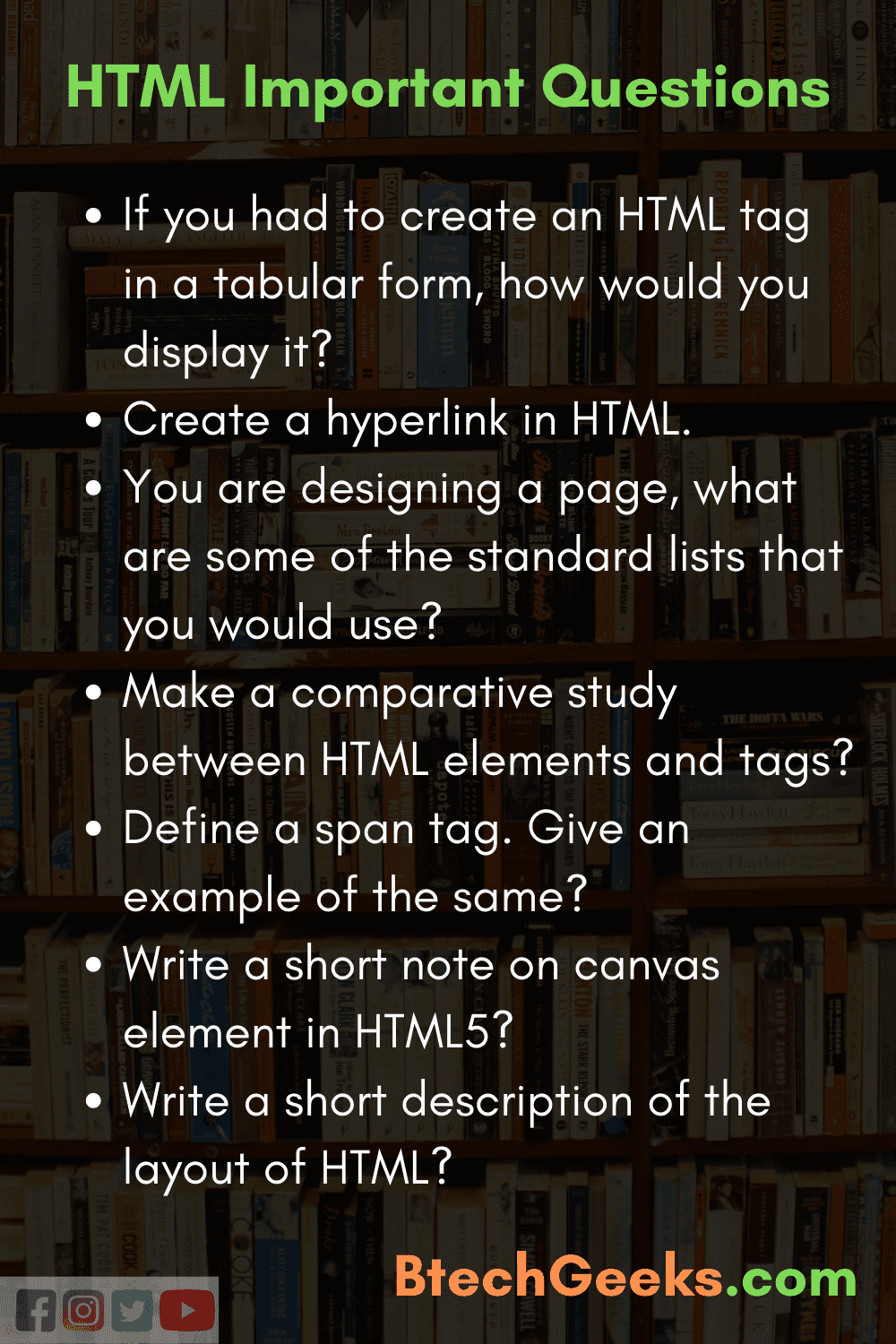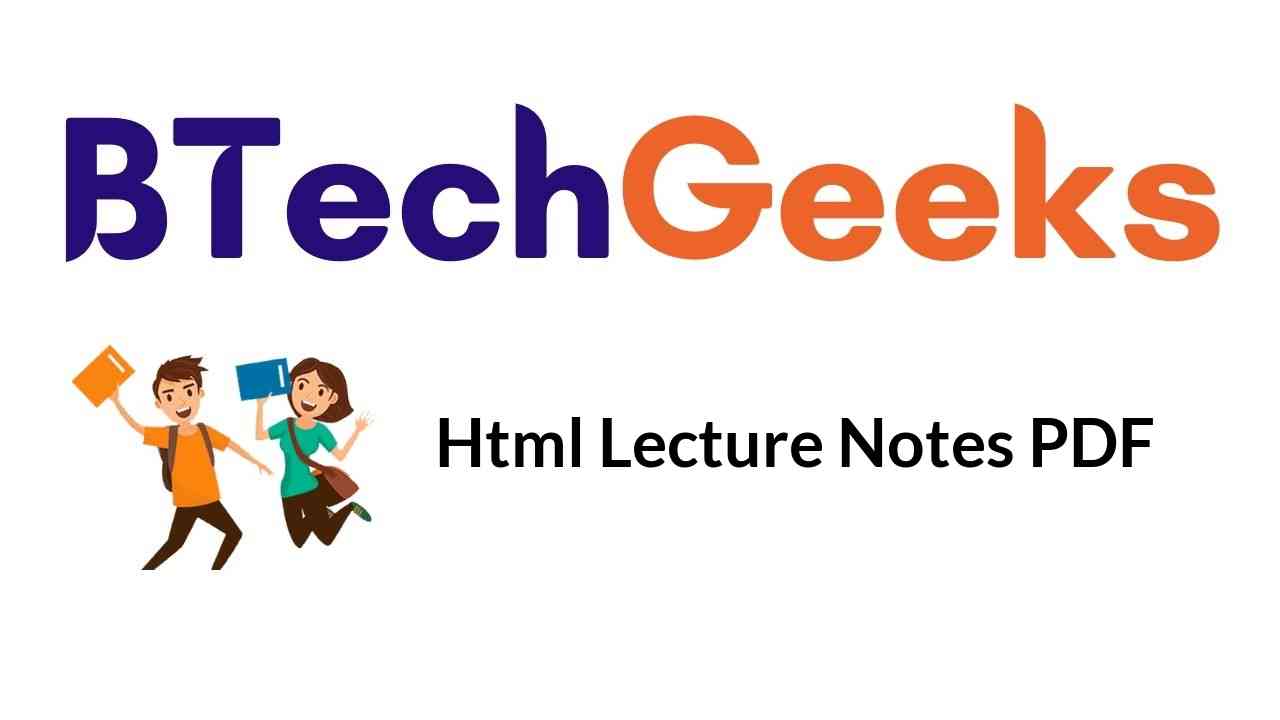HTML Lecture Notes PDF: Are you looking to access web pages for HTML Lecture notes all over and fed up? Don’t Worry as we will guide you on this and be with you in your way of preparation. Through this webpage, students can access and download the best HTML Lecture Notes as per the latest syllabus.
HTML Notes give students a head start compared to the other students as they can access many different sources of study material. The Webpage over here is created in a way that you do not have to look out for other resources. Using the HTML Preparation Material given by subject experts you can score well in your exams and stand out from the crowd.
- What is HTML?
- HTML Lecture Notes and Study Material PDF Free Download
- HTML Reference Books
- HTML Curriculum
- List of HTML Important Questions
- FAQs on HTML Lecture Notes
What is HTML?
HTML stands for Hypertext Markup Language. When a user wants to create and structure sections, paragraphs and heading for web pages and applications, they can do it with the help of HTML. It would be best if you don’t confuse HTML with a programming language. The main reason for that is HTML can’t create dynamic functionality. HTML is a program that makes it possible for users to organize and format documents. It is a similar function to Microsoft Word.
HTML Lecture Notes and Study Material PDF Free Download
Graduates who are learning HTML study notes can access the best and reliable sources of Lecture HTML Notes and Study Material updated on this page. It is important to prepare from the trusted sources so that you will be able to score well.
Students can download and access the HTML Lecture Notes and Html Study material pdf and refer to them during the preparation or revision process. We advise students to use the HTML Lecture Notes, Html course notes and Study Materials to enhance their overall knowledge and understanding of topics within.
Here is a list of a few credible and comprehensive Hypertext Markup Language Notes and Study Material for a thorough preparation –
- HTML Lecture Handwritten Notes Pdfs
- HTML Handwritten Notes Pdfs
- Html Notes Pdf Free Download
- Html Complete Notes
- HTML Lecture Notes Pdfs
- HTML Reference Books Pdfs
- HTML Programme Question Paper Pdfs
- Html Handwritten Notes Pdf Download
- Html And Css Handwritten Notes Pdf
- Html5 Handwritten Notes Pdf
- Html Hand Written Notes
- Html Written Notes Pdf
- Html Full Notes Pdf Free Download
- Html Short Notes Pdf
- Html Notes Pdf Download
- Html Notes Download
- Html Pdf Notes Free Download
HTML Reference Books
Reference Books are the best sources to start gaining additional information regarding the subject. It gives students a good understanding of the concepts of HMTL. Candidates need to read from latest books for HTML.
Students can enhance their preparation by referring to the most recommended HTML Lecture Books on a page. The list of best, latest, and highly recommended books for HTML preparation is as follows. Students can select the right books that meet their knowledge, needs, and requirements and prepare accordingly.
- Learning Web Design written by Jennifer Robbins
- Alexander Clyde wrote PHP
- Get Coding!
- HTML and CSS: Design and Build Websites
- WordPress For Beginners 2019 written by Salman Khurshid
- HTML 101 written by Jo Foster
- HTML & CSS written by Daniel Bell
- Jeanie Meyer wrote the Guide of HTML5 and JavaScript

HTML Curriculum
One of the vital steps while preparing for exams is to go through the syllabus. The syllabus gives students a chance to start their preparation according, and make a plan for their preparation period. The best way to start your preparation process is by making a proper preparation plan as per the HTML Syllabus.
The HTML course curriculum gives students an overview of what to study, how to start their preparation process and organize their studies. The Web Page on Lecture HTML Notes PDF provides students with a detailed view of the syllabus, taking into consideration every student’s requirements and needs. Students get a unit-wise break-up which allows them to allot time to each topic in the syllabus.
Students should study and cover all the essential concepts before they attempt the HTML examination. When students study all the topics and attempt their examination, they will feel more comfortable attempting the question paper. Aspirants should stay aware and should keep up with all the updates of the HTML syllabus as it prevents wasting unnecessary time on irrelevant topics.
The updated and latest unit-wise breakup of the latest and updates HTML Syllabus are as follows:
Unit I:
- HTML Basics
- HTML Introduction
- HTML Elements
- Attributes
- HTML Headings
- Paragraphs
- HTML Formatting
- Fonts
- Styles
- HTML
- Links
- Images
- tables
- HTML Lists
- Forms
- Frames
- HTML color
- Colournames
- Colourvalues
- HTML Quick List
Unit II
- XML Programming- I
- Introduction
- The need for XML
- Structured Data and Formatting
- Advantages of XML
- SGML
- XML
- HTML
- World Wide Web Consortium (W3C)
- Specifications and Grammars
- XML applications and Tools
- Creations and Viewing
- XML Documents
- Transforming XML Documents
- XML Document Syntax
- Validating XML Documents with DTDs
- XML Namespaces
Unit III
- XML Programming- II
- Introduction
- Transforming XML Documents with XSLT and XPath
- Formatting XML Documents with XSL- FO
- Purpose of XSL Formatting Objects (XSL- FO)
- XSL- FO Documents and XSL- FO Processors
- XSL- FO Namespace
- Page Format Specifiers
- Page Content Specifiers
Unit IV
- XML- Programming- III
- Validating XML Documents with Schemas
- Introduction to Simple Object Access Protocol (SOAP)
- SOAP’s use of XML and Schemas
- Elements of a SOAP
- Handling SOAP Faults
- Current SOAP Implementations
- Introduction to Web Services
- Architecture and Advantages of Web series
- Purpose of Web Services Description Language (WSDL)
- WSDL Elements
- Creating and Examining WSDL Files
- Overview of Universe Description, Discovery and Integration (UDDI)
- UDDI Registries (Public and Private)
- Core UDDI Elements
- Deploying and Consuming Web Services
- XML Specifications EbXML Registry and Repository
- Introduction to XML Document Object Model (XMLDOM)
Unit V
- XML Applications
- B2B Scenarios
- e-business system involved
- delivery sales
- cross-company communication
- replacement for EDI
- the document as the application
- XML and relational databases
- XML and Dynamic web publishing
- benefits of XML schemas to applications
- XML processors enforcing structure
- application access to document structure
- fixed values
- channels
Unit VI:
- Ajax- Asynchronous JavaScript and XML – overview
- Web Applications- Pre and Post Ajax
- Ajax in the Real-world
- Alternatives to Ajax
- XML in a nutshell
- syntax
- rules
- javascript in a nutshell
- primitive data types and reference types
- variables loops
- function definition and function call
- objects
- expressions
- operators and escape sequences
- document object model (DOM)
- window object
- HTML & XML DOM
- Node
- element
- accessing element nodes
- Inner HTML
- Properties of element and text nodes
- node attributes, node name and node value
- event handling
- keyword- this
- whitespace interpretation
- browser differences
- removing nodes
- creating new nodes
- node methods
Unit VII:
- Ajax- XML http Request Object
- XML http request instantiation
- XML http Requestion open () method
- Asynchronous Vs Synchronous requests
- callback function
- ready state
- CSS in a nutshell
- Synatx
- Units
- Selectors
- Positioning properties
- Float property
- types od positioning 3D
- XML and Ajax
- Creating a DOM Document with JavaScript
- load XML
- receiving XML responses from the server
- Passing XML to the server 90
- Different server side technologies- an overview
- Some popular frame works- in brief
Unit VIII:
- AJAX- Object-oriented Java Script
- Multiple simultaneously asynchronous request
- prototype
- extending built-in objects
- object-oriented XML Http request
- Refactoring to the creation and handling pf XHR Http request
- Model-View-Control (MVC)
- Design Patterns
- MVC Examples
- Ajax Web Application
- Java Script Object Notation (JSON)
- Java script object and array creation using Literals
- Javascript objects in arrays and array in objects
- JSON Syntax
- JSON Parsers
Unit IX:
- AJAX- XSLT
- XSLT
- Overview
- XSLT in the Browsers
- Sarissa
- Advantages and Disadvantages
- XPath-Overview
- Drag and Drop
- Overview
- Scriptaculous
- Draggable options
- Droppables
- Drag and Drop Ajax and scriptaculous apendix
- Download/ Install Software- wamp
- regular expressions
- some characteristics of regular expressions Metacharacters
- Non-assertions and quantifiers
- assertions and quantifiers
- XML Basics
- XML Benefits
- XML Parsers
- Content Management
- Web Services
- A document type Declaration
- Elements attributes
- CDATA
- Special Characters
Unit X
- J2ME
- Java Environment Comparisons
- J2ME
- J2SE
- J2ME Specifics
- ME Components
- MIDP- Comparison of different ME platforms
- profiles- overview of the profile system
- Architecture- How the J2ME world
- MIDP: Mobile information device profile
- creating MIDP applications
- Midlet suites and deployment
- MIDP GUI: Graphical User Interfaces with MIDP
- Displays
- Commands
- Pointers
- Screens
- Animations and drawing
- Data Structures: Storing data in Java
- Hash Table and Hash Map
- Vector and List
- Comparison between different types
- inner classes
- using inner classes
- types of inner classes
- anonymous
- inner
- member
- static
- exceptions
- IO and networking
- error handling
- streamed IO
- Socket IO
- J2ME IO
- Connector architecture
- networking with HTTP
- Threading
- Creating threads in Java
- Synchronisation
Unit XI:
- Introduction to HTML5
- HTML5
- how did HTML 5 get started ?
- Rules for HTML5
- New Features
- Browser support
- new elements in HTML5
- New Markup Elements
- New Media Elements
- The canvas element
- New Form Elements
- New input type attribute values
- video on the web
- video formats
- how it works
- all <video> attributes
Unit XII:
- HTML5- Audio and Canvas
- Audio on the web
- Audio Formats
- How it works
- all <audio> attributes
- HTML5 Canvas Examples
- what is canvas?
- create a canvas element
- draw with Ajax script
- understanding coordinates
- more canvas examples
- HTML5 web staorage
- storing data on the client
- the local storage object
- the session storage object
- HTML5 Input types
- Browser support
- Input Type- email
- input type- url
- input type- numer
- input type- range
- input type- date pickers
- inout type- search
- input type- colour
Unit XIII:
- HTML5 Form Elements and Attributes
- HTML5 New form elements
- browser support
- datalist element
- keygen element
- output element
- HTML5 Form attributes
- HTML5 New From attributes
- Browser support
- autocomplete attribute
- autofocus attribute
- form override attributes
- height and width attributes
- attribute
- min, max and step attributes
- HTML5 Tag Reference
- HTML5 Global Attributes
- HTML5 Event attributes
- Global Event Attributes
- Window Event Attributes
- Form Events
- Keyboard Events
- Mouse Events
- Media Events
Unit XIV:
- WAP Simulator for Mobile Phones
- Introduction
- WAP toolkit software includes: WML and WML script encoders
- phone simulators
- WML Deck and Card
- WML Document structure
- Character data
- WML Entities
- Prolog
- XML declaration and character encoding
- comments in WML
- Line breaking in WML
- Paragraphs and line Breaks
- Text formatting
- WML Tables
- Wireless Bitmap (WBMP)
- Links
- <anchors> tag
- <a> tag
List of HTML Important Questions
Students who are pursuing the HTML programme can read through the list of the essential questions mentioned below for HTML. All the review questions mentioned are the most commonly asked questions in exams.
- If you had to create an HTML tag in a tabular form, how would you display it?
- Create a hyperlink in HTML.
- You are designing a page, what are some of the standard lists that you would use?
- Make a comparative study between HTML elements and tags?
- Define a span tag. Give an example of the same.
- Write a short note on canvas element in HTML5.
- Define a data tag list.
- If you have to a multi-coloured text on a web page, how would you do it? Explain.
- Write a short description of the layout of HTML.

FAQs on HTML Lecture Notes
Question 1.
What is HTML?
Answer:
HTML stands for Hypertext Markup Language. When a user wants to create and structure sections, paragraphs and heading for web pages and applications, they can do it with the help of HTML. It would be best if you didn’t confuse HTML with a programming language. The main reason for that is HTML can’t create dynamic functionally. HTML is a programme that makes it possible for users to organise and format documents.
Question 2.
What are some of the study materials that students can access in the article for HTML in this article?
Answer:
Here are some of the study materials references that students can access for HTML in this article:
- HTML Lecture Handwritten Notes Pdfs
- HTML Handwritten Notes Pdfs
- HTML Lecture Notes Pdfs
- HTML Reference Books Pdfs
- HTML Programme Question Paper Pdfs
Question 3.
Name some of the books that students can refer to for HTML?
Answer:
Here are some of the books that students can refer to for HTML:
- Learning Web Design written by Jennifer Robbins
- Alexander Clyde wrote PHP
- Get Coding!
- HTML and CSS: Design and Build Websites
- WordPress For Beginners 2019 written by Salman Khurshid
Question 4.
List some of the critical questions for HTML.
Answer:
Here are some of the essential questions for HTML:
- If you had to create an HTML tag in a tabular form, how would you display it?
- Create a hyperlink in HTML.
- You are designing a page, what are some of the shared lists that you would use?
- Make a comparative study between HTML elements and tags?
- Define a span tag. Give an example of the same.
- Write a short note on canvas element in HTML5.
Also Read: PHP Lecture Notes
Conclusion
The article on HTML Lecture Notes is a reliable, and knowledgeable source of information that helps candidates prepare more efficiently for their examination. Students can access essential and latest reference books, review essential questions, and read through the HTML syllabus. This article allows students to access and download the HTML Lecture Notes pdfs for reference and practice from the list of questions.

